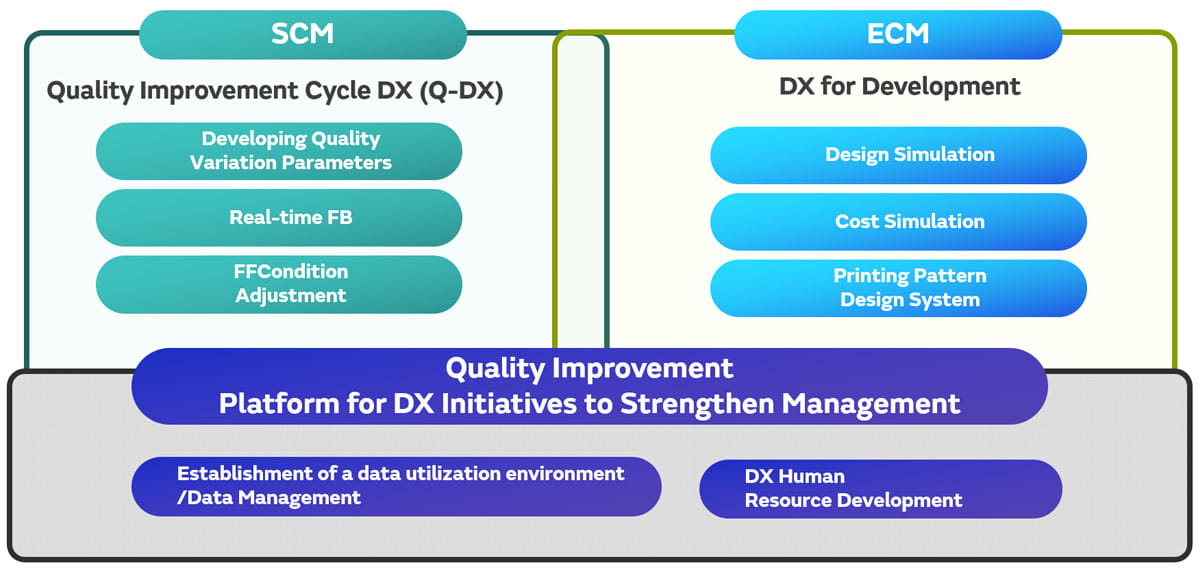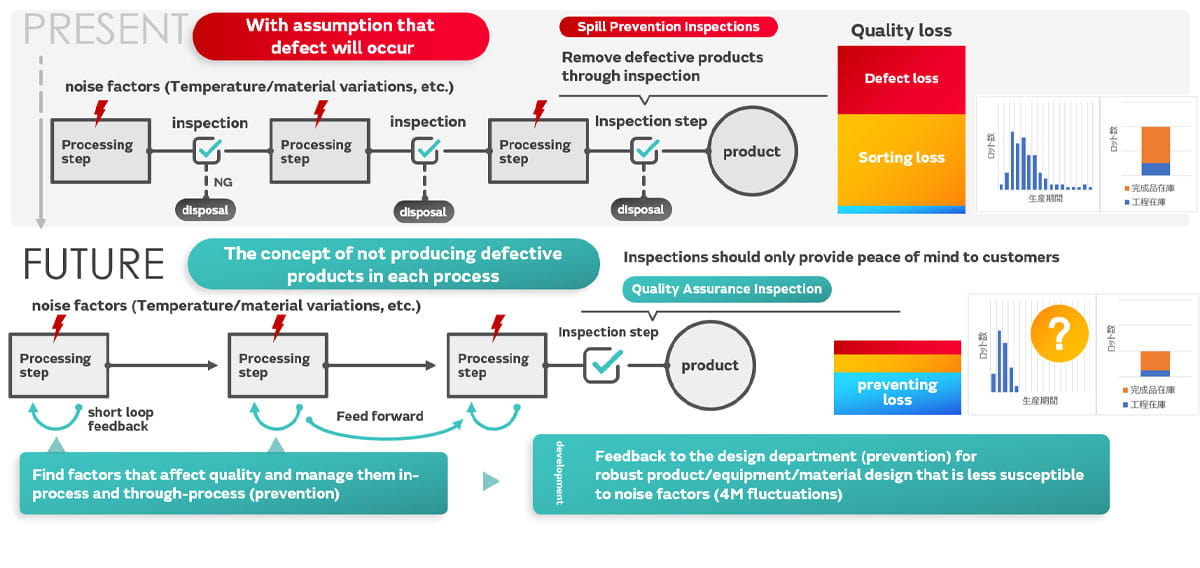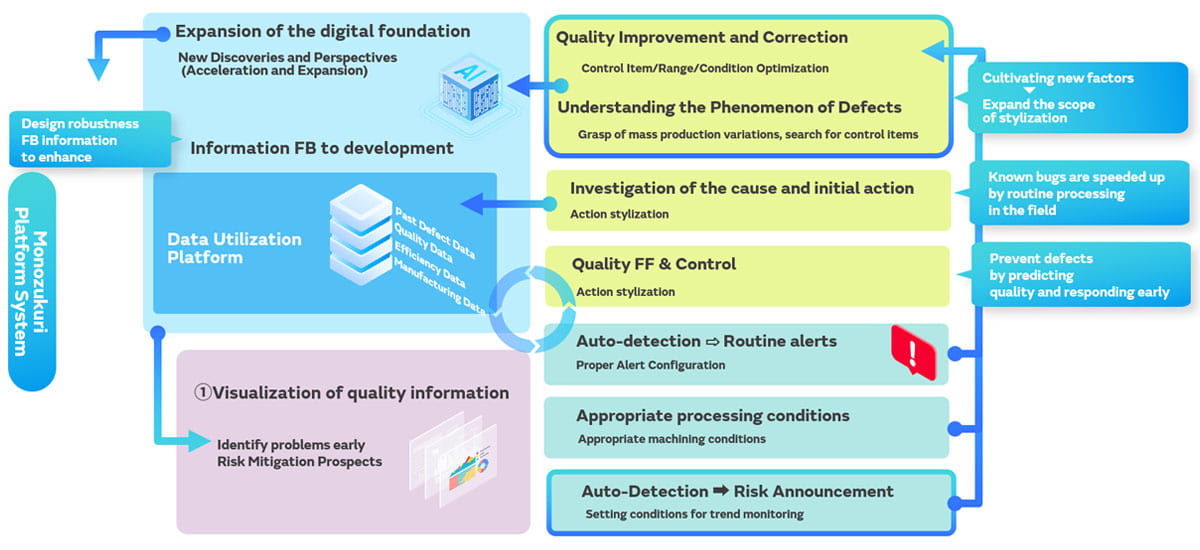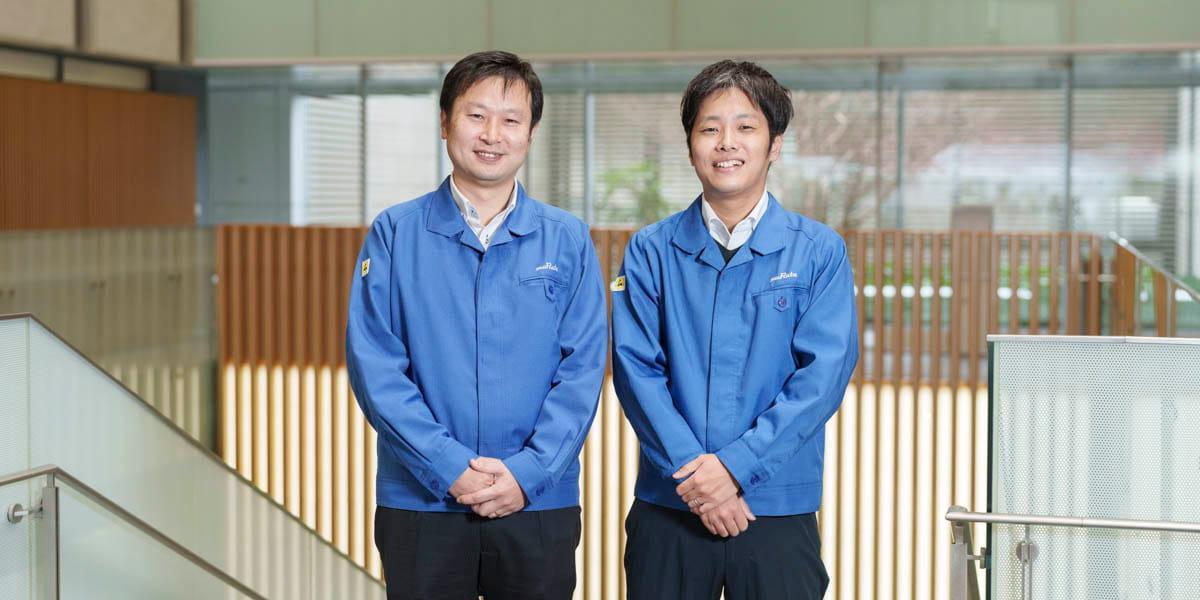DX×Murata: The future of manufacturing that is evolving through DX
The future of manufacturing after redesigning work processes
INDEX
1. Building an integrated data utilization infrastructure to eliminate silos
2. Reviewing manufacturing processes to consider mechanisms for preventing defects
3. Aiming for consistent "Made by Murata" quality by standardizing work
4. Orient all Murata toward reviewing the entire company from the perspective of BPR
As production lines continue to expand, the manufacturing industry is facing a major issue: the tendency of improvements to become more individually optimized (that is, the creation of silos). Murata is now reviewing and redesigning work from the perspective of business process re-engineering (BPR), in order to resolve this issue. In this article, Naito (Takefu Manufacturing Department #1) of Fukui Murata Manufacturing and Yamauchi (Manufacturing Management Department, Manufacturing Enhancement Promotion Department) discuss what manufacturing will look like after BPR.
1. Building an integrated data utilization infrastructure to eliminate silos
Multilayer ceramic capacitors (MLCCs) are a major product of Murata, and the company's global market share of these products is expanding. As a market expands, so does the amount of work required, including launching and supporting overseas production sites, transferring control, and managing process management systems and tools. According to Naito, this also presents an issue for manufacturing.
Naito: "In addition having more work to do, quality issues with MLCC high-end products are becoming more difficult to handle. We've been making improvements to resolve these issues, but decided to consult Yamauchi in the Manufacturing Management Department because we figured that it would be important to seek out the root causes so we could simply prevent any defects from occurring."
Yamauchi: "The Manufacturing Enhancement Promotion Department normally provides suggestions on improvements to manufacturing departments, so we thought it would be a good idea to work together on solving the problem. One of Murata's medium-term challenges was to switch from chasing issues to improving manufacturing quality to the point where issues no longer occur, and we had formed a concept for quality DX activities (Q-DX) to achieve the future of manufacturing."
Yamauchi leveraged his experience promoting DX with various manufacturing departments to reflect back on "issues that had occurred due to silos forming during company-wide DX efforts, such as too many systems and data redundancy." Naito added that they had also struggled with the same issue for MLCCs.
Naito: "We have around 15 MLCC production lines around the world, and each site is working on its own improvements. That means each site is using its own systems, databases, and applications. This is called a silo, and we came up with the idea of building an integrated data utilization infrastructure in order prevent this from happening and set consistent standards across sites."
Adopting such an integrated and comprehensive perspective is key for Q-DX.
Naito: "Our MLCC manufacturing departments are situated between engineering chain management (ECM) and supply chain management (SCM). They have access to both development personnel and the manufacturing site, so we decided we needed a single database to handle from both, and thought that a data utilization infrastructure connecting ECM and SCM would be crucial."

2. Reviewing manufacturing processes to consider mechanisms for preventing defects
What is the best way to seek out and eliminate the root causes of defects, so that products can be manufactured without defects on MLCC production lines? The answer is BPR. Murata was able find solutions by fundamentally reviewing existing organizations, rules, and processes, and redesigning workflows and systems.
Yamauchi: "Our goal is to build smooth production lines free of product stagnation and disorder. It's not easy. However, we thought we would be able to use what we learned in our smart factory and DX initiatives and apply that toward BPR to reduce quality variation, and build production lines that function reliably."
Naito: "We used to remove defects found during inspections between multiple machining processes, so that only good products could get through. However, this assumes that some defects will get through. In order to make improvements, we proposed a mechanism to prevent defects from occurring, by reviewing all of these processes to find anything impacting quality, and standardizing and automating the short feedback and feedforward processes."

3. Aiming for consistent "Made by Murata" quality by standardizing work
Naito: "MLCC manufacturing tends to result in irregular quality variation. While working on a range of quality improvements, we noticed that there were some things we couldn't catch simply with smart factory and DX technologies. For this most recent BPR effort, we focused on standardization including these irregular factors, and on discovering added value such as seeking out unknown factors."
According to Naito, the Manufacturing Management Department reviewed everything back to the work design step, and worked on standardizing work in a range of areas beginning with troubleshooting quality variations.
Naito: "We're also considering how we should standardize the manufacturing infrastructure system we eventually want to create. For example, if we could automatically detect quality variation and send out standard alerts, a standard process could be used to handle known defects on site. We could also gather data on defects with unknown causes and continue to standardize cause surveys and initial actions for new quality variation, in order to expand the scope of standardization and discover even more added value."

Naito: "We could also feed this data back to the design department to prevent variation from occurring from the design step. Running through the standardization loop based on a manufacturing infrastructure system makes it easier to take permanent measures that don't rely on individual skills or experiences. Our goal is to achieve 'Made by Murata' quality, where we can ensure consistent QCDS no matter where a product is made."
Yamauchi: "Reviewing work through BPR also means throwing away work we've already done, which we thought was good at the time. It's very difficult to involve the site with BPR initiatives, but it's also important to eliminate issues based on ECRS* when making improvements. We want to engage with BPR with a sense of preparedness and responsibility, and ultimately expand the manufacturing infrastructure system throughout all Murata."
*ECRS: Eliminate, Combine, Rearrange, Simplify
4. Orient all Murata toward reviewing the entire company from the perspective of BPR
Naito explains that these initiatives taken based on BPR are meant to "liven up how personnel work on site."
Naito: "No one would be motivated if we just drop a new data infrastructure on site. It's important for them to learn how to use it themselves, redesign their own work based on common rules, and take an active role. Once we're done building the system, we want personnel on site to keep using it and also to continue to update it and make it better. We're prepared to do whatever it takes to teach people what they need to know, in order to get the environment set up properly."
Yamauchi: "It's extremely important for personnel on site to build mechanisms on their own. Although we use digital tools to handle data, these are just a means to an end. The important thing is to change how people on site think and work, and to contribute value to our customers and the business. The best case scenario would be for personnel on site to continue to review and improve work even if we're not around."
While they hope that workers will change how they work and think, both men agree that there are some things that should never change.
Yamauchi: "In manufacturing, the three 'actuals' and principles are unchanging values. As you standardize work, you can spend more time at actual sites dealing with actual things and actual facts. The goal is not to use digital tools, but to use DX as an opportunity to completely review how you work and to contribute to society and our customers. This has always been important at Murata, and will continue to be so in the future."
Naito: "Have people do what they need to and what only they can do, and leave the rest to digital tools and machines. This is how you create new things and discover unknown causes. If we can build a common data infrastructure for sharing techniques and knowledge, anyone could access it, learn how to use it, and maybe even get some hints on creating new innovations."
Yamauchi: "The amount of data handled at Murata has exploded over the last few years. We now have many database and system silos throughout the organization, and I think now is the time to orient all Murata toward reviewing the entire company from the perspective of BPR. I hope that Q-DX will be at the foundation of these efforts, and I'm confident that we can leverage Murata's excellent manufacturing and improvement capabilities in accomplishing this."

